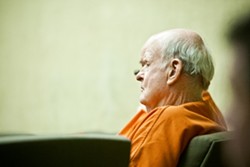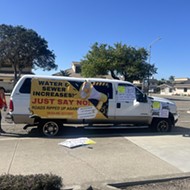Lawyers, jail, and money: A convoluted tale of conspiracies, arrests, and high courtroom drama
By Rhys Heyden[
{
"name": "Promo Temp Targeted",
"id": "PromoTempTargeted",
"class": "inlineCenter",
"insertPoint": "4",
"component": "15511697",
"requiredCountToDisplay": "0"
},
{
"name": "Ad - Medium Rectangle CC01 - 300x250 - Inline Content",
"class": "inlineCenter",
"insertPoint": "8",
"component": "15582119",
"requiredCountToDisplay": "12"
},{
"name": "Ad - Medium Rectangle LC01 - 300x250 - Inline Content",
"class": "inlineCenter",
"insertPoint": "18",
"component": "15582122",
"requiredCountToDisplay": "22"
},{
"name": "Ad - Medium Rectangle 9 - 300x250 - Inline Content",
"class": "inlineCenter",
"insertPoint": "28",
"component": "15582121",
"requiredCountToDisplay": "32"
}]
Scott Bryan Whitenack, 55, sat behind reinforced glass in an orange jumpsuit at the San Luis Obispo County Jail visiting room. His eyes were bloodshot, and his beard was flecked with gray. As he picked up the telephone, his mouth was already moving:
“I’m an attorney,” he said, “and I believe all of this is retaliatory.”
Over the course of an hour on Oct. 4, Whitenack spun an elaborate story about how he ended up in jail. Originally charged with three felonies and three misdemeanors on Sept. 9, Whitenack said he was targeted by a vengeful former employer and falsely arrested by several SLO County law enforcement agencies.
“These violations have happened to me; I didn’t imagine them,” Whitenack said. “I speak my mind, I speak the truth, and I back it up with the law.”
Intrigued by Whitenack’s claims, New Times spent several weeks attending court hearings, examining court documents, and interviewing Whitenack and a variety of his associates.
Though most of his allegations proved to be either untrue or impossible to verify, Whitenack’s case offers an intriguing view into the pitfalls of the criminal justice system and, above all else, the enigma of Whitenack himself.
The arrests
Whitenack has been an active member of the State Bar of California since 1982, but his first documented run-in with the law came earlier this year.
On March 3, Whitenack was arrested on suspicion of being drunk in public, a misdemeanor, in Pismo Beach, after allegedly smoking marijuana, parking his car up on a curb at the Pismo Pier, and loudly ranting at several police officers.
Five months later, on Aug. 18, Whitenack was booked for two more misdemeanors: allegedly driving with a suspended license and giving false information—a pseudonym—to a peace officer, again in Pismo Beach.
A few weeks later, Whitenack found himself in more hot water. After a month-long investigation, he was arrested on Sept. 9 for three suspected felonies, dating back to an Aug. 3 incident. The charges were second-degree burglary, false personation, and petty theft.
According to court testimony and a personal account, this latest arrest stemmed from an incident at a private event at the Avila Bay Athletic Club, which Whitenack allegedly crashed with his girlfriend and another individual. Club employees alleged that Whitenack was generally drunk and belligerent, signed in using a false name, and stole a valuable necklace.
“It did appear they were drunk, they were showing the necklace to our staff and asking them to put it on, and [Whitenack] totally grossed everyone out because he yelled ‘It makes your tits look great’ to his girlfriend in the middle of the lobby,” said Nancy Terrell, general manager of the club.
SLO County sheriff’s deputies later secured a warrant and arrested Whitenack at his mother’s house in Orcutt, over the Avila incident. One of the arresting deputies testified that Whitenack was hiding under a bed sheet at the time.
Stuck in SLO County Jail for the conceivable future, Whitenack did what any attorney would do: He organized his case and prepared to represent himself.
New Times had the opportunity to review several legal documents Whitenack filed while he was held in jail. Riddled with typos, full of digressions, and imbued with the conviction of a practiced proselytizer, the documents seek to entirely exonerate their author.
Essentially, Whitenack sought to recuse the entire District Attorney’s Office due to conflicts of interest, a request that was, unsurprisingly, denied. When that failed, Whitenack painted a picture of pervasive law enforcement corruption that, he claimed, resulted in several illegal and persecutory arrests.
Subsequently, Whitenack filed several broad “motions to suppress” evidence in his case—arguing that warrants were served without probable cause, searches were conducted illegally, and that police actions in general were retaliatory.
Three days after speaking with New Times in jail, Whitenack was set for a decisive hearing on his motions to suppress evidence.
The backstory
In order to fully appreciate Whitenack’s courtroom drama, it’s essential to first know his background.
Whitenack grew up in Pasadena, the son of singer and entertainer Troy Cory and mother Dorothy Swafford. Whitenack’s father was a semi-famous crooner and TV host who also toured extensively in China. He was initially represented by Sonny Bono.
Whitenack’s parents divorced when he was still relatively young, and he said he never had a strong father figure in his life as a result. He undertook his undergraduate studies at Ventura College and earned his law degree at the San Fernando Valley College of Law.
All of that is beyond dispute, but almost every other element of Whitenack’s life is questionable in some way, shape, or form—even down to his name.
By law, he is still Scott Bryan Whitenack, but he refers to himself by a wide variety of names online and in person: Scott Belli, Scott Whitenack-Belli, Scott Stubblefield, and Scott Stubblefield-Whitenack.
His father, who went by Troy Cory, was born Keith Stubblefield, so that’s the origin of one of the appendages. The other name comes from infamous attorney Melvin Belli, whom Whitenack claims was a mentor and an inspiration—in addition to having a famous, bankable last name.
In court documents and in person, Whitenack has insisted that he personally worked with Melvin Belli. In one court document, Whitenack claimed he worked with Belli from 1982 to 1996.
“I never actually worked in Belli’s office, but I worked in association with him on cases,” Whitenack later told New Times. “I wanted to do entertainment law, and follow in the footsteps of my father and Melvin.”
Whitenack even went so far as to stick the Belli family name in his Santa Maria law firm: The Law Offices of Belli & Belli.
Melvin Belli’s son, Melvin Caesar Belli, told New Times that Whitenack might have done some small contract work for the Belli law firm many years ago, but Whitenack’s involvement with the family has been very minimal.
Belli added that his late father had represented Whitenack’s father, Troy Cory, on a few lawsuits decades ago.
“Scott was never a partner or an associate, so he’s just pulling the Belli name out of thin air,” Belli said. “I have no idea what he’s doing, but I feel bad for him.”
At the root of this confusion is a divisive issue: Whitenack was diagnosed as manic depressive/bipolar in 2007. He freely admitted the diagnosis and said he’s been on and off the antipsychotic Abilify, but said it doesn’t affect his law practice or personal convictions.
“That’s the label they decided to put on me,” Whitenack said. “To me, manic just means your mind is moving faster than everyone else’s. There’s nothing wrong with me.
“People try to use that to say I’m paranoid or somehow delusional, but doctors have said I’m highly intelligent and that there’s no problem,” he said.
Others, however, beg to differ.
Darryl Genis is a prominent Santa Barbara-based DUI attorney who knew and employed Whitenack for several years before Whitenack left Genis’ firm in January 2013.
“He’s not stable, in my opinion,” Genis told New Times. “It’s a very sad, tragic, case of a bright man with a real disease that’s going untreated.”
Genis vs. Whitenack
In the months building up to Whitenack’s arrest, his public and private squabbles with Genis played a major role.
Genis said he first hired Whitenack as an “appearance” lawyer, using him sporadically to fill in on cases, starting in 2010 or 2011. At the beginning of 2012, Genis hired Whitenack as a full-time associate.
“Scott was a good worker bee, he got along with people, and he documented files meticulously and carefully,” Genis said. “That said, if you backed Scott up against the wall and a case went to trial, he fell apart. He wasn’t a trial lawyer.”
Around the time of an office Christmas party in 2012, Genis said Whitenack gave him his month’s notice, saying that he had reconnected with a former sweetheart and was moving down to L.A.
On Whitenack’s last day of work, Genis said that warning bells went off in his head for the very first time. On that day, Whitenack asked Genis to defend him on a potential contempt of court violation with Santa Barbara Superior Court Judge Edward Bullard, a judge Genis said “had the patience of a saint.” Whitenack was never cited, but it was strange to Genis nonetheless.
“I was thinking to myself, ‘what’s going on?’” Genis said. “A few weeks later, after Scott had left and I dug around a little bit, I was shocked to find out that he was bipolar, off his medication, totally wigged out, and trying to steal clients from me.”
For his part, Whitenack accuses Genis of having “a lot of animosity” against him and being “vindictive.” Whitenack claims Genis intimidated clients and witnesses of his, and also had a private eye follow him around.
“It’s not paranoia if you’re actually being followed,” Whitenack said.
“I never hired a private eye to follow him, nor would I ever do that,” Genis responded. “That’s utterly ridiculous.”
The main conflict between the two attorneys was over the DUI case of Robert Scott Sproston. The case, currently mired in appeals, is an ongoing, hotly contested legal dispute over whether or not the Pismo Beach Police Department systematically suppressed evidence for DUI arrests.
Sproston was brought into the firm by Genis, initially represented by Whitenack in the case’s preliminary stages, and then represented by Genis after Whitenack left. However, Whitenack briefly convinced Sproston to come over to his own Santa Maria practice in February 2013, before Genis convinced Sproston that such a move was a bad idea.
“Scott tried—unsuccessfully and unethically—to steal Sproston from me, and it didn’t work,” Genis said.
“Sproston wanted me to take over his case, but Darryl was very vindictive and blocked that,” Whitenack countered.
Genis said he wasn’t surprised that his former colleague had ended up in jail, but added that he felt sorry for him and hoped that jail time would encourage him to re-medicate.
“My mother is bipolar, so I know about the disease,” Genis said. “The symptoms are around 50 percent enjoyable, and who wants to give up that high? He’s not stupid; he just lives in a true fantasy world.”
Whitenack denied that his condition had anything to do with the acrimonious split and said he just “didn’t feel comfortable” working for Genis anymore.
The hearing
On the afternoon of Oct. 7, after spending almost a month in SLO County Jail, Whitenack was finally back in lawyer mode.
Despite sporting hand and leg cuffs along with his orange jumpsuit, he enthusiastically cross-examined four law enforcement officers involved in his three arrests for more than four cumulative hours.
Three of the officers were from the Pismo Beach PD, and Whitenack repeatedly attempted to make a connection between his arrest and his work on the Sproston case, claiming all of the charges he was facing were retaliatory and that there was a broad conspiracy afoot.
As Whitenack emphasized several times, the officer who arrested Sproston, William Garret, retired a few months after the arrest.
Superior Court Judge John Trice, visibly grimacing and furrowing his brow, repeatedly asked Whitenack to narrow his line of questioning to make it relevant to the motion at hand. Whitenack, however, stuck with his “broad conspiracy” strategy.
Whitenack, claiming it would exonerate him, wanted to view dash-camera video of his arrests in court. Judge Trice was reluctant to take that step. As Trice was postponing a further motion continuance until the next week, Whitenack and Deputy District Attorney Thomas Wilson appeared to reach an unexpected, last-second plea deal.
The judge was called back in to mediate, and the deal progressed—until it reached the last step. Wilson wanted Whitenack to agree to a year of probation, and Whitenack bluntly refused. So he went back to jail.
Freedom … and further complications
Whitenack, undeterred by the setback, was able to negotiate an acceptable plea deal with Wilson just two days later.
Under that deal, each of the six charges was reduced to a misdemeanor, four were dismissed, and he pleaded no contest to the charges of petty theft and driving with a suspended license. He was released from jail on Oct. 11, with the only stipulations being adherence to a short probation period and a $30 restitution payment for the necklace.
“I saw that I wasn’t going to get justice in Trice’s court, so I took the plea deal,” Whitenack said. “I’m going to have my day in court when I bring my RICO [Racketeer Influenced and Corrupt Organization] allegations against local law enforcement.”
Genis, however, said that a RICO case, under the circumstances, would be “impossible” to prove.
One unexpected benefit for Whitenack stemming from his month of jail time was picking up several new clients—among them infamous former Grover Beach financier Al Moriarty and alleged drug offender Richard Granger.
Moriarty is alleged to have defrauded his clients of up to $22 million in a massive “Ponzi-like” scheme, and has been held on a $5 million bail since May 2013.
During an Oct. 16 bail reduction hearing for Moriarty, Whitenack—newly released from jail and sporting a gray suit paired with a neon green shirt—officially snatched the reins on Moriarty’s case away from stunned attorney Tom Allen.
Whitenack handed out a sympathetic poem about Moriarty’s plight, written by a fellow inmate, and argued that Moriarty’s painful hip condition and his desire to look after his aging wife at home necessitated a bail reduction.
Judge Jacquelyn Duffy had denied a similar request on June 12, but Judge Barry LaBarbera remained noncommittal on Whitenack’s motion, continuing the hearing until Oct. 24.
Upon hearing the news that Whitenack had taken over Moriarty’s case, Genis said he was greatly saddened and worried.
“If this guy, carrying around so many peccadilloes, is un-medicated, doing dishonest things, and still being allowed to practice law, that’s unbelievable,” Genis said. “If he can convince a really troubled 80-year-old man whom he met in jail to dismiss a truly talented lawyer, then that’s a tragedy.”
Whitenack said he sees no such tragedy, and has been invigorated since getting out of jail.
“Al is a really nice person. He approached me in jail with his case, and I’m glad to be representing him,” Whitenack said.
“Scott is going to go off like a firecracker, there’s no question. Something bad is going to happen with Moriarty because of Scott. It’s sad, but that’s what I’m expecting to see,” Genis said.
For his part, Whitenack said he’s enjoying life post-incarceration, currently living with his mother in Orcutt, and looking forward to re-establishing his practice in Santa Maria.
“I didn’t need to advertise. People just came up to me in jail,” Whitenack said. “I’m excited.”
Staff Writer Rhys Heyden can be reached at [email protected].
Latest in News
Readers also liked…
-

SLO police identify alleged driver who hit and killed couple
Dec 22, 2022 -

When the levee breaks: Oceano residents, county officials walk a tightrope of regulations to manage Arroyo Grande Creek, which some say led to the levee's failure in January
May 18, 2023 -

Cal Poly report highlights offshore wind's potential to spur green energy transition
Jun 8, 2023







